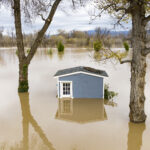An Army Corps of Engineers policy is threatening trees and shrubs on 1,600 miles of Calif., Central Valley levees.
The policy requires levees to be cleared of all vegetation to preserve channel capacity and allow access for inspections and repairs.
It’s based largely on conditions along the Mississippi and Missouri rivers, where levees were built back from the rivers and there is ample wildlife habitat between the levees and the water’s edge.
But levees were built close to the water in California to create high water velocity to wash mining debris out of the rivers following the Gold Rush.
Removing trees and shrubs from the California levees would create barren culverts, critics of the federal policy say.
“Let’s not forget we are a proud city of trees,” said Gregory Kondos, a Sacramento artist whose paintings of tree-lined levees have earned him a following. “We are going to lose a landmark. It’s not going to be anything we can be proud of.”
Spokesman Dana Cruikshank said the corps is drafting a new national policy that would allow some small trees and shrubs to remain.
“Mostly very small brush, very small trees in some circumstances could remain, but not anything beyond a very small tree,” he said. “And of course there will be some spots where there would be no vegetation at all.”
Brig. Gen. John McMahon, a regional commander for the corps in California, said he hopes to persuade officials to tailor the new national policy to meet California’s needs.
“There is no doubt in my mind our headquarters would like one standard applied broadly across the full spectrum of levees,” he said. “I personally don’t think that’s the right tack to take in this situation. Not all vegetation on levees is bad.”
McMahon thinks the new policy should allow trees to remain where levee strengthening is not an issue.
Local levee districts that fail to comply with the corps’ policy would not be eligible for federal assistance to repair levees after a flood.
Mike Hardesty, president of the Central Valley Flood Control Association, said removing levee vegetation could get levee districts in trouble with other state and federal agencies for destroying habitat.
“It’s hard to say how draconian these (vegetation removal) measures will be,” said Gary Hobgood, an environmental scientist with the California Department of Fish and Game. “As it stands now, California has lost 97 percent of its riparian habitat since the arrival of Europeans. So we’re down to this last thread of habitat.”
Was this article valuable?
Here are more articles you may enjoy.

 When a Neighborhood Floods, Foreclosures Often Follow
When a Neighborhood Floods, Foreclosures Often Follow  Four Ex-VW Managers Convicted in Germany Over Diesel Scandal
Four Ex-VW Managers Convicted in Germany Over Diesel Scandal  AF Group Claims Exec Embracing AI, But He Won’t Measure Success by Replacing People
AF Group Claims Exec Embracing AI, But He Won’t Measure Success by Replacing People  Central US Severe Weather Outbreak Caused Billions in Damages, AccuWeather Says
Central US Severe Weather Outbreak Caused Billions in Damages, AccuWeather Says 